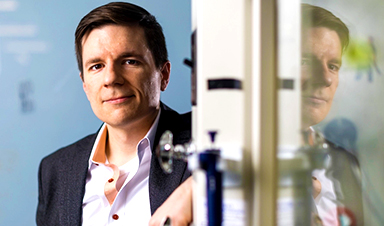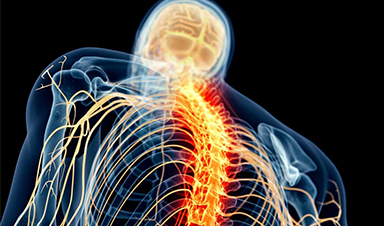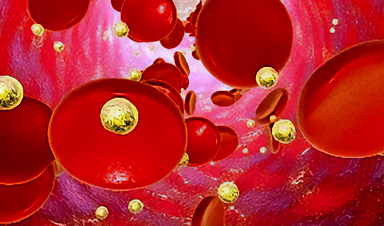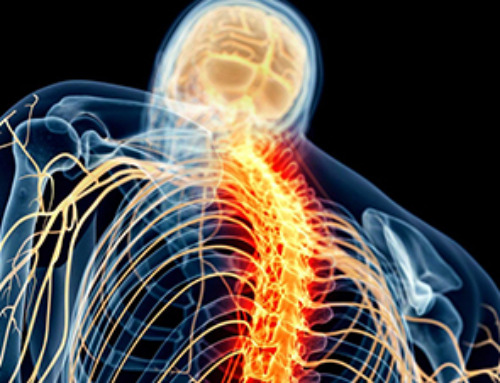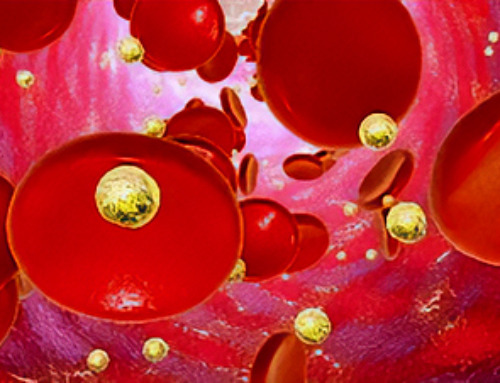| Some researchers are driven by the quest to improve a specific product, like a battery or a semiconductor. Others are motivated by tackling questions faced by a given industry. Rob Macfarlane, MIT’s Paul M. Cook Associate Professor in Materials Science and Engineering, is driven by a more fundamental desire. | |
| “I like to make things,” Macfarlane says. “I want to make materials that can be functional and useful, and I want to do so by figuring out the basic principles that go into making new structures at many different size ranges.” |
| He adds, “For a lot of industries or types of engineering, materials synthesis is treated as a solved problem — making a new device is about using the materials we already have, in new ways. In our lab’s research efforts, we often have to educate people that the reason we can’t do X, Y, or Z right now is because we don’t have the materials needed to enable those technological advances. In many cases, we simply don’t know how to make them yet. This is the goal of our research: Our lab is about enabling the materials needed to develop new technologies, rather than focusing on just the end products.” | |
| By uncovering design principles for nanocomposites, which are materials made from mixtures of polymers and nanoparticles, Macfarlane’s career has gradually evolved from designing specks of novel materials to building functional objects you can hold in your hand. Eventually, he believes his research will lead to new ways of making products with fine-tuned and predetermined combinations of desired electrical, mechanical, optical, and magnetic properties. | |
| Along the way Macfarlane, who earned tenure last year, has also committed himself to mentoring students. He’s taught three undergraduate chemistry courses at MIT, including his current course, 3.010 (Synthesis and Design of Materials), which introduces sophomores to the fundamental concepts necessary for designing and making their own new structures in the future. He also recently redesigned a course in which he teaches graduate students how to be educators by learning how to do things like write a syllabus, communicate with and mentor students, and design homework assignments. | |
| Ultimately, Macfarlane believes mentoring the next generation of researchers is as important as publishing papers. | |
| “I’m fortunate. I’ve been successful, and I have the opportunity to pursue research I’m passionate about,” he says. “Now I view a major component of my job as enabling my students to be successful. The real product and output of what I do here is not just the science and tech advancements and patents, it’s the students that go on to industry or academia or wherever else they choose, and then change the world in their own ways.” | |
From nanometers to millimeters |
|
| Macfarlane was born and raised on a small farm in Palmer, Alaska, a suburban community about 45 minutes north of Anchorage. When he was in high school, the town announced budget cuts that would force the school to scale back a number of classes. In response, Macfarlane’s mother, a former school teacher, encouraged him to enroll in the science education classes that would be offered to students a year older than him, so he wouldn’t miss the chance to take them. | |
| “She knew education was paramount, so she said ‘We’re going to get you into these last classes before they get watered down,’” Macfarlane recalls. | |
| Macfarlane didn’t know any of the students in his new classes, but he had a passionate chemistry teacher that helped him discover a love for the subject. As a result, when he decided to attend Willamette University in Oregon as an undergraduate, he immediately declared himself a chemistry major (which he later adjusted to biochemistry). | |
| Macfarlane attended Yale University for his master’s degree and initially began a PhD there before moving to Northwestern University, where a PhD student’s seminar set Macfarlane on a path he’d follow for the rest of his career. | |
| “[The PhD student] was doing exactly what I was interested in,” says Macfarlane, who asked the student’s PhD advisor, Professor Chad Mirkin, to be his advisor as well. “I was very fortunate when I joined Mirkin’s lab, because the project I worked on had been initiated by a sixth-year grad student and a postdoc that published a big paper and then immediately left. So, there was this wide-open field nobody was working on. It was like being given a blank canvas with a thousand different things to do.” | |
| The work revolved around a precise way to bind particles together using synthetic DNA strands that act like Velcro. | |
| Researchers have known for decades that certain materials exhibit unique properties when assembled at the scale of 1 to 100 nanometers. It was also believed that building things out of those precisely organized assemblies could give objects unique properties. The problem was finding a way to get the particles to bind in a predictable way. | |
| With the DNA-based approach, Macfarlane had a starting point. | |
| “[The researchers] had said, ‘Okay, we’ve shown we can make a thing, but can we make all the things with DNA?’” Macfarlane says. “My PhD thesis was about developing design rules so that if you use a specific set of building blocks, you get a known set of nanostructures as a result. Those rules allowed us to make hundreds of different crystal structures with different sizes, compositions, shapes, lattice structures, etc.” | |
| After completing his PhD, Macfarlane knew he wanted to go into academia, but his biggest priority had nothing to do with work. | |
| “I wanted to go somewhere warm,” Macfarlane says. “I had lived in Alaska for 18 years. I did a PhD in Chicago for six years. I just wanted to go somewhere warm for a while.” | |
| Macfarlane ended up at Caltech in Pasadena, California, working in the labs of Harry Atwater and Nobel laureate Bob Grubbs. Researchers in those labs were studying self-assembly using a new type of polymer, which Macfarlane says required a “completely different” skillset compared to his PhD work. | |
| In 2015, after two years of learning to build materials using polymers and soaking up the sun, Macfarlane plunged back into the cold and joined MIT’s faculty. In Cambridge, Macfarlane has focused on merging the assembly techniques he’s developed for both polymers, DNA, and inorganic nanoparticles to make new materials at larger scales. | |
| That work led Macfarlane and a group of researchers to create a new type of self-assembling building blocks that his lab has dubbed “nanocomposite tectons” (NCTs). NCTs use polymers and molecules that can mimic the ability of DNA to direct the self-organization of nanoscale objects, but with far more scalablility — meaning these materials could be used to build macroscopic objects that can a person can hold in their hand. | |
| “[The objects] had controlled composition at the polymer and nanoparticle level; they had controlled grain sizes and microstructural features; and they had a controlled macroscopic three-dimensional form; and that’s never been done before,” Macfarlane says. “It opened up a huge number of possibilities by saying all those properties that people have been studying for decades on these nanoparticles and their assemblies, now we can actually make them into something functional and useful.” | |
A world of possibilities |
|
| As Macfarlane continues working to make NCTs more scalable, he’s excited about a number of potential applications. | |
| One involves programming objects to transfer energy in specific ways. In the case of mechanical energy, if you hit the object with a hammer or it were involved in a car crash, the resulting energy could dissipate in a way that protects what’s on the other side. In the case of photons or electrons, you could design a precise path for the energy or ions to travel through, which could improve the efficiency of energy storage, computing, and transportation components. | |
| The truth is that such precise design of materials has too many potential applications to count. | |
| Working on such fundamental problems excites Macfarlane, and the possibilities coming from his work will only grow as his team continues to make advances. | |
| “In the end, NCTs open up many new possibilities for materials design, but what might be especially industrially relevant is not so much the NCTs themselves, but what we’ve learned along the way,” Macfarlane says. “We’ve learned how to develop new syntheses and processing methods, so one of the things I’m most excited about is making materials with these methods that have compositions that were previously inaccessible.” |
News
3D-printed implant offers a potential new route to repair spinal cord injuries
A research team at RCSI University of Medicine and Health Sciences has developed a 3-D printed implant to deliver electrical stimulation to injured areas of the spinal cord, offering a potential new route to [...]
Nanocrystals Carrying Radioisotopes Offer New Hope for Cancer Treatment
The Science Scientists have developed tiny nanocrystal particles made up of isotopes of the elements lanthanum, vanadium, and oxygen for use in treating cancer. These crystals are smaller than many microbes and can carry isotopes of [...]
New Once-a-Week Shot Promises Life-Changing Relief for Parkinson’s Patients
A once-a-week shot from Australian scientists could spare people with Parkinson’s the grind of taking pills several times a day. The tiny, biodegradable gel sits under the skin and releases steady doses of two [...]
Weekly injectable drug offers hope for Parkinson’s patients
A new weekly injectable drug could transform the lives of more than eight million people living with Parkinson's disease, potentially replacing the need for multiple daily tablets. Scientists from the University of South Australia [...]
Most Plastic in the Ocean Is Invisible—And Deadly
Nanoplastics—particles smaller than a human hair—can pass through cell walls and enter the food web. New research suggest 27 million metric tons of nanoplastics are spread across just the top layer of the North [...]
Repurposed drugs could calm the immune system’s response to nanomedicine
An international study led by researchers at the University of Colorado Anschutz Medical Campus has identified a promising strategy to enhance the safety of nanomedicines, advanced therapies often used in cancer and vaccine treatments, [...]
Nano-Enhanced Hydrogel Strategies for Cartilage Repair
A recent article in Engineering describes the development of a protein-based nanocomposite hydrogel designed to deliver two therapeutic agents—dexamethasone (Dex) and kartogenin (KGN)—to support cartilage repair. The hydrogel is engineered to modulate immune responses and promote [...]
New Cancer Drug Blocks Tumors Without Debilitating Side Effects
A new drug targets RAS-PI3Kα pathways without harmful side effects. It was developed using high-performance computing and AI. A new cancer drug candidate, developed through a collaboration between Lawrence Livermore National Laboratory (LLNL), BridgeBio Oncology [...]
Scientists Are Pretty Close to Replicating the First Thing That Ever Lived
For 400 million years, a leading hypothesis claims, Earth was an “RNA World,” meaning that life must’ve first replicated from RNA before the arrival of proteins and DNA. Unfortunately, scientists have failed to find [...]
Why ‘Peniaphobia’ Is Exploding Among Young People (And Why We Should Be Concerned)
An insidious illness is taking hold among a growing proportion of young people. Little known to the general public, peniaphobia—the fear of becoming poor—is gaining ground among teens and young adults. Discover the causes [...]
Team finds flawed data in recent study relevant to coronavirus antiviral development
The COVID pandemic illustrated how urgently we need antiviral medications capable of treating coronavirus infections. To aid this effort, researchers quickly homed in on part of SARS-CoV-2's molecular structure known as the NiRAN domain—an [...]
Drug-Coated Neural Implants Reduce Immune Rejection
Summary: A new study shows that coating neural prosthetic implants with the anti-inflammatory drug dexamethasone helps reduce the body’s immune response and scar tissue formation. This strategy enhances the long-term performance and stability of electrodes [...]
Scientists discover cancer-fighting bacteria that ‘soak up’ forever chemicals in the body
A family of healthy bacteria may help 'soak up' toxic forever chemicals in the body, warding off their cancerous effects. Forever chemicals, also known as PFAS (per- and polyfluoroalkyl substances), are toxic chemicals that [...]
Johns Hopkins Researchers Uncover a New Way To Kill Cancer Cells
A new study reveals that blocking ribosomal RNA production rewires cancer cell behavior and could help treat genetically unstable tumors. Researchers at the Johns Hopkins Kimmel Cancer Center and the Department of Radiation Oncology and Molecular [...]
AI matches doctors in mapping lung tumors for radiation therapy
In radiation therapy, precision can save lives. Oncologists must carefully map the size and location of a tumor before delivering high-dose radiation to destroy cancer cells while sparing healthy tissue. But this process, called [...]
Scientists Finally “See” Key Protein That Controls Inflammation
Researchers used advanced microscopy to uncover important protein structures. For the first time, two important protein structures in the human body are being visualized, thanks in part to cutting-edge technology at the University of [...]
